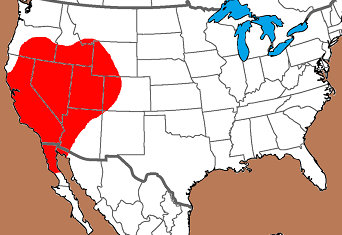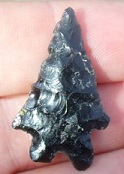This is a medium triangular expanding stemmed point with a flattened to elliptical cross section. The blade is primarily excurvate, but may vary to straight. The blade is commonly serrated on this point. The shoulders may range from slightly barbed to having an upward angle. The stem may vary from slightly expanding to straight. The base is concave forming a bifurcated stem. The flaking pattern may vary from random to parallel oblique.
Size Measurements: Total Length - 24 to 65 mm (average 33 to 51 mm), Stem Length - 7
to 11 mm, Blade Width - 15 to 52 mm (average 18 to 24 mm), Neck
Width - 10 to 32 mm (typically 13 to 17 mm), Stem Width - 13 to 42
mm (typically 10 to 20 mm narrower than the blade), Thickness 4 to 9 mm
This point is found through-out the Great Basin, into the Snake River Plain and into southeastern Oregon into the Klamath Valley. These points may be found into the northern Colorado Plateau. They are found westward into the Sacramento River Valley. These points are found southward into northern Baja California and northwestern Sonora Mexico.



















Heizer was an eminent anthropologist and a professor at the University of California – Berkley. Heizer was influential in promoting our understanding of the archaeology of California and Nevada. Baumhoff was a distinguished anthropologist and serves as the Chair in the Department of Anthropology, University of California – Berkley. He conducted extensive studies into the archaeology of California. This type was named in a professional publication and has many professional references. This is considered a valid type.
.